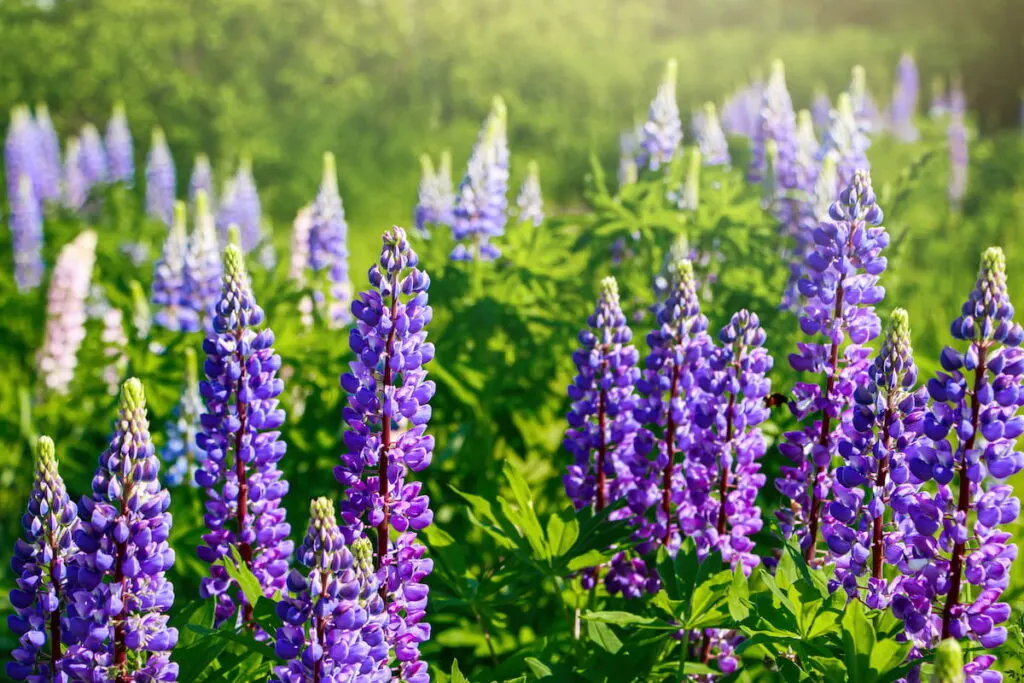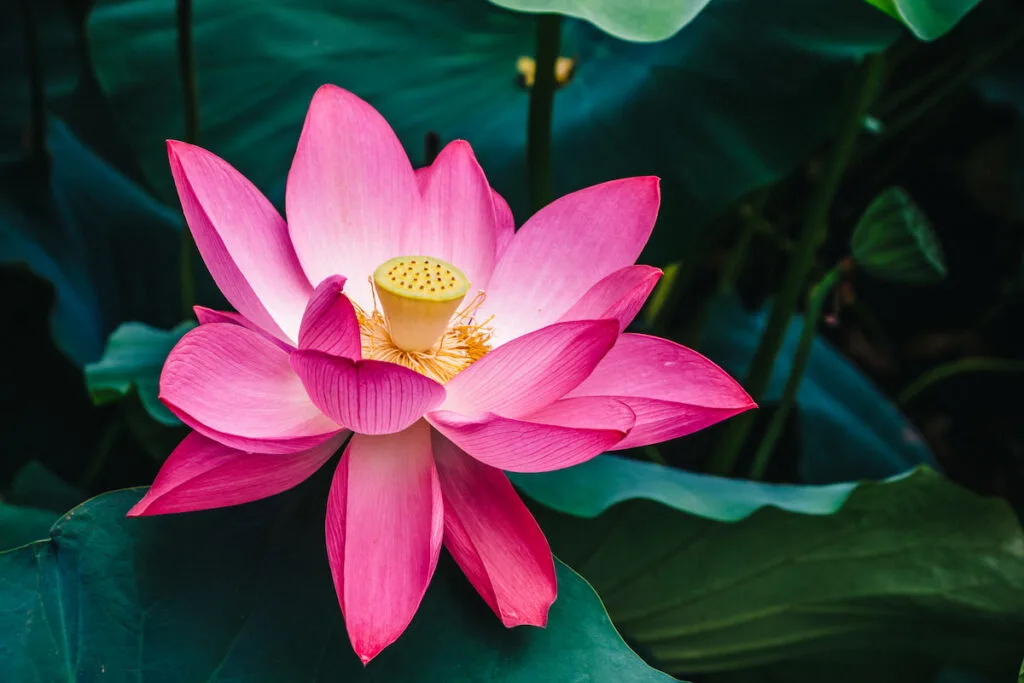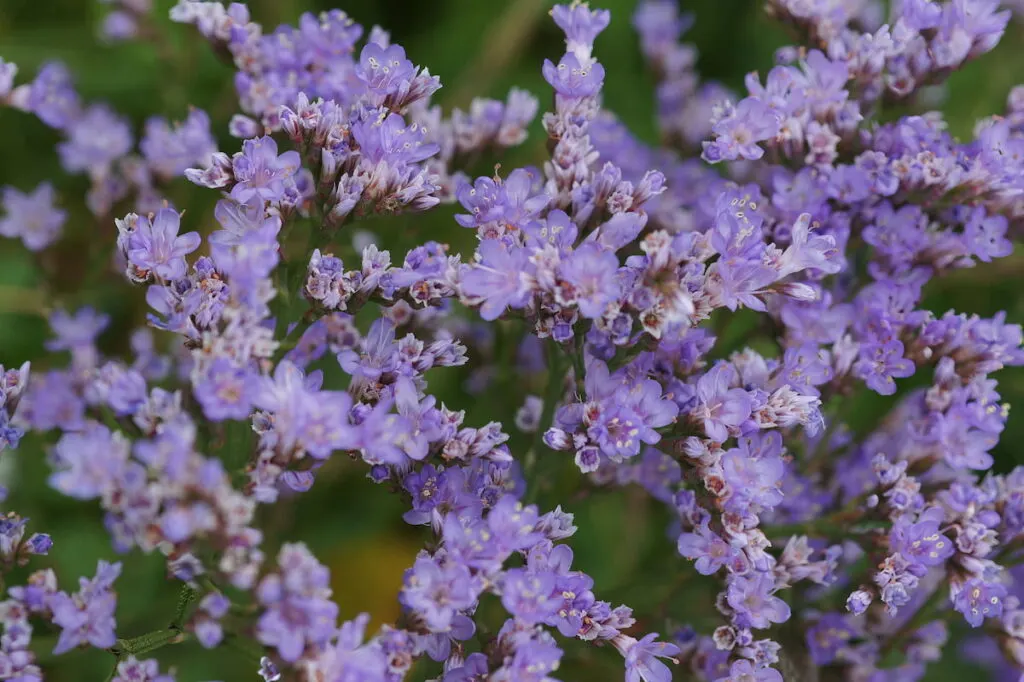Flowers are a great way to dress up your garden, patio, or indoor arrangement. There are big, bright ones, and there are also tiny, delicate ones.
The wide variety of flower types beginning with the letter L is perfect for all kinds of gardening arrangements. From modern flower fashions to traditional cottage gardens, we have covered them all.
Table of Contents
1. Lavender

Lavender is a fragrant plant, which can range in color from white to deep purple and is a treat for almost all of the senses.
One of lavender’s best-known qualities is its ability to stimulate a state of serenity. For generations, people have appreciated lavender’s fragrant essential oil, tasty culinary uses, and therapeutic powers.
The lavender plant is a member of the mint family and is native to the Mediterranean region. It thrives in bright sunlight and is extremely hardy but requires well-drained soil.
2. Lily

Lilies are beautiful and fragrant flowers that bloom from early summer to late fall.
The lily bloom is large and has six petals arranged in a star shape. The blossoms of lilies come in a rainbow of colors, including white, pink, yellow, orange, and red.
Lilies are a type of herbaceous blooming plant that grows from a bulb. Sunlight is essential for their growth; they require at least six hours daily.
3. Lilac

Lilacs are a favorite shrub for many gardens due to their clusters of violet blossoms and pleasant scent. And because they come in sizes ranging from dwarf three-footers to small trees, they may be placed in nearly any garden.
There is a wide range of varieties of lilacs, each with a unique blooming schedule and color palette, so that you may enjoy white, light pink, purple, or intense burgundy flowers all summer.
Lilacs require full sun and moist, well-drained soil. Established plants may survive periods of dryness, but too much water or shade can cause powdery mildew.
4. Lupine

Lupine’s towering spikes of flowers are conspicuously out of place among the palmate vegetation.
Lupines are bright-blooming flowers which can grow four feet high. They are an excellent addition to the borders of gardens with an English or rustic style.
Lupine prefers full sun and well-draining soil, and you should ensure these conditions are met, or lupines will not thrive. Lupines can also be grown in the shade but expect fewer blossoms.
5. Lewisia

Lewisia is a low-growing, drought-resistant plant endemic to the western United States. Its appealing fleshy leaves and cup-shaped blooms come in a broad spectrum of bright colors.
Lewisia thrives even in poor, dry soil, making it a great addition to rock gardens, containers, and the edges of walks because it requires little maintenance.
Lewisia flowers require full or partial sun and moderate water until established.
6. Love-in-a-mist

Love-in-a-mist, also known as Nigella damascena, is an older-style flower with a lot of charm. The flowers come in a wide range of hues, from deep violet to pastel blue, with the occasional pink, lavender, or white specimen.
This stunning plant blooms primarily during the spring and early summer.
The relaxed atmosphere of a cottage or country garden is ideal for these attractive plants. It is also beautiful when used in dried bouquets.
7. Love-Lies-Bleeding
Love-lies-bleeding, also known as the tassel flower, features lovely pale-green leaves with deep-red, cascading clusters.
Once planted, this decorative plant can grow to a height of five feet with very little maintenance.
Love lies bleeding not only survives in dry conditions but thrives on poor soil, where it produces more robust and numerous blossoms.
It can become invasive if the plant is allowed to self-sow, so removing the seed heads regularly is important.
8. Lily of the Valley

Lily of the Valley is a popular choice for bouquets and floral arrangements due to its attractive appearance and pleasant scent.
Typically found in wooded areas, lily of the valley blooms white bell-shaped flowers in the spring and reaches a height of about 10 inches.
Even though it is pretty small, this plant has a surprisingly strong fragrance and joyfully expands to cover a large area.
Lily of the valley thrives in cool, damp conditions, so plant it where you can provide some shade. It may spread freely under trees and other overhanging bushes.
9. Liatris

The liatris plant is commonly referred to as a gayfeather or a blazing star.
Most years, you may enjoy a beautiful display of liatris flowers from July through late September.
The fuzzy, thistle-like blossoms of the liatris grow along their tall spikes, and unlike most plants, they bloom from the top down rather than the typical bottom up.
They thrive in bright sunlight, but many species also tolerate partial shade. Also, these plants can withstand dry conditions and even some frost.
Most liatris types are hardy in USDA plant hardiness zones 5-9; with mulch, some can survive in zones 3 and 4.
10. Larkspur
Larkspur is a staple of the classic cottage garden and a reliable bloomer for bouquets.
The flowers of the larkspur, which can be anything from a deep navy to a pale baby blue, are one of the few true blue flower species.
The numerous petals of some larkspur varieties give them the appearance of pom poms.
This plant can be used in various ways in the garden, from being planted alone to being part of a wild mixture of annuals and perennials.
Larkspur is a true annual that grows quickly from seed and happily spreads by itself. It flowers for a few weeks, from mid-spring until mid-summer.
11. Lobelia

As an annual, lobelia is a versatile plant for your flower beds, planters, and baskets.
Pollinators such as butterflies, bees, and hummingbirds are drawn to lobelia’s small but prolific blooms, which appear throughout the summertime and into the fall.
Some lobelia species form thick mats, but the vast majority spread out in a trailing manner.
Although many different lobelia flower hues are available, the traditional sky-blue type is by far the most well-known. But there are also a variety of purples, whites, pinks, and lilacs.
12. Lechenaultia

Lechenaultia is a genus of small-sized Western Australian species valued for their showy spring and summer blooms.
Despite their fragile appearance, lechenaultias are hardy plants that thrive in sunny locations and withstand light frosts.
Lechenaultia, which has some of the most beautiful blue flowers of any plant, is an excellent choice for planting in a rock garden where drainage is optimal. Those flowers perish quickly in poorly drained soil.
13. Lotus

The lotus, a perennial aquatic plant that flourishes in nutrient-rich, murky environments, is the national flower of India and Vietnam.
Lotus has a life cycle unlike any other plant. The life cycle of a lotus flower is unique. It has mud-encrusted roots, yet each night it is washed in the river, and each morning it mysteriously re-blooms, clean as a whistle.
As a result of this transformation, the flower has taken on symbolic meaning in various cultures, including that of new beginnings and enlightenment, purity, rebirth, awakening, and strength.
14. Ladybells
Ladybells, often called false campanula, are a spectacular addition to any woodland or rural garden setting.
They exemplify the attractiveness and simplicity of this style of garden setting with their lovely bell-shaped pendulous blossoms and pleasant azure blue color.
Ladybells are perennials that bloom in late spring, and their flowers are fragile but spectacular and mildly fragrant.
As long as the soil is rich and wet and the weather is warm, ladybells are low-maintenance, long-blooming plants that require little attention.
15. Leucojum

Leucojum, commonly called summer snowflake, is a spring-blooming bulb with zero maintenance and is a hardy plant.
Even though the flowers and foliage of leucojum are identical to snowdrops, this plant is roughly twice as tall and blooms around two months later, typically right after the daffodils.
Trailing stalks are topped with white, bell-shaped flower clusters with lime-green points. The bulbs are dependable perennials that will continue to produce spring flowers year after year.
16. Limonium

The common name for Latifolium is Limonium. It is an herbaceous perennial or annual (above zone 8) native to the Mediterranean. The summertime is prime flowering time.
The limonium plant’s structure is bushy, and its blossoms come in a rainbow of hues. It resembles gypsophila in that it has many branches, and at the tips of those branches are little clusters of blooms.
Dried limonium is a common component of floral displays. Despite being a lovely flower, limonium has the unfortunate quality of smelling like cat urine.
Final Thoughts
If you have forgotten the name of the flower but know that it begins with the letter L, or if you need the last word in your crossword, I hope you were able to find it here fast and easily.
If, on the other hand, the letter L holds a special place in your heart and you are searching for new specimens for your collection, I have included a description of sixteen unique and beautiful flower species.
A perfect blossom for a minimalistic or modern garden may be found here, as well as one that is more natural and rustic.
However, for the flowers to flourish, it is important to consider the fundamentals when deciding, such as choosing a species well suited to your location’s climate, the garden’s spot, and the aesthetic goals you have for the flower arrangement.
Resources
- https://www.thespruce.com/how-to-grow-and-care-for-lobelia-5082044
- https://www.nurseriesonline.com.au/plant-index/australian-native-plants/lechenaultia/
- https://www.townandcountrymag.com/leisure/arts-and-culture/a9550430/lotus-flower-meaning/
- https://www.longfield-gardens.com/article/all-about-leucojum/
- https://www.thespruce.com/ladybell-plant-profile-5088228
- https://www.trianglenursery.co.uk/flower-guides/limonium-guide
